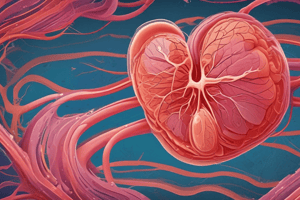Podcast
Questions and Answers
What aspect of muscle fibers does the oxidative metabolic system primarily affect?
What aspect of muscle fibers does the oxidative metabolic system primarily affect?
- Aesthetic appearance
- Endurance capacity (correct)
- Recovery time
- Strength potential
Which type of muscle fibers are predominantly involved in oxidative metabolism?
Which type of muscle fibers are predominantly involved in oxidative metabolism?
- Type IIa fibers
- Type IIb fibers
- Type III fibers
- Type I fibers (correct)
What is a primary benefit of an efficient oxidative metabolic system in muscle fibers?
What is a primary benefit of an efficient oxidative metabolic system in muscle fibers?
- Reduction in muscle stiffness
- Enhanced power output
- Increased muscle hypertrophy
- Improved oxygen consumption (correct)
How does the oxidative metabolic system impact fatigue during prolonged exercise?
How does the oxidative metabolic system impact fatigue during prolonged exercise?
In what way can training enhance the oxidative metabolic system in muscle fibers?
In what way can training enhance the oxidative metabolic system in muscle fibers?
What is dynamic endurance primarily focused on?
What is dynamic endurance primarily focused on?
Which factor is indicated as essential for muscle performance in endurance activities?
Which factor is indicated as essential for muscle performance in endurance activities?
In the context of muscle endurance, which of the following statements is accurate?
In the context of muscle endurance, which of the following statements is accurate?
Which type of endurance is most related to how muscles respond to repeated movements?
Which type of endurance is most related to how muscles respond to repeated movements?
What role does glycogen play in muscle endurance?
What role does glycogen play in muscle endurance?
What is the definition of muscle power?
What is the definition of muscle power?
Which of the following units is used to measure muscle power?
Which of the following units is used to measure muscle power?
How is muscle strength distinct from muscle power?
How is muscle strength distinct from muscle power?
What does the term 'endurance' refer to in the context of muscles?
What does the term 'endurance' refer to in the context of muscles?
Which of the following statements about muscle performance is correct?
Which of the following statements about muscle performance is correct?
What characteristic distinguishes slow-twitch fibers from fast-twitch fibers?
What characteristic distinguishes slow-twitch fibers from fast-twitch fibers?
Which energy system do slow-twitch fibers primarily depend on?
Which energy system do slow-twitch fibers primarily depend on?
How do the contraction speed and force of slow-twitch fibers compare to fast-twitch fibers?
How do the contraction speed and force of slow-twitch fibers compare to fast-twitch fibers?
What is a primary functional advantage of slow-twitch fibers?
What is a primary functional advantage of slow-twitch fibers?
Which statement about slow-twitch fibers is incorrect?
Which statement about slow-twitch fibers is incorrect?
What is a characteristic of the heart size in marathoners compared to normal individuals?
What is a characteristic of the heart size in marathoners compared to normal individuals?
What is the resting cardiac output level before exercise typically measured at?
What is the resting cardiac output level before exercise typically measured at?
To what level does cardiac output increase during intense exercise such as marathon running?
To what level does cardiac output increase during intense exercise such as marathon running?
How does the cardiovascular system adapt during exercise?
How does the cardiovascular system adapt during exercise?
What is typically observed in the hearts of trained athletes like marathoners?
What is typically observed in the hearts of trained athletes like marathoners?
What is the maximum body temperature that can be reached in hot and humid conditions before adverse effects occur?
What is the maximum body temperature that can be reached in hot and humid conditions before adverse effects occur?
Which of the following is NOT a symptom of heatstroke?
Which of the following is NOT a symptom of heatstroke?
Which is the most effective treatment method for heatstroke?
Which is the most effective treatment method for heatstroke?
What can result from a body temperature reaching dangerous levels due to heatstroke?
What can result from a body temperature reaching dangerous levels due to heatstroke?
Which symptom of heatstroke can indicate severe risk to health?
Which symptom of heatstroke can indicate severe risk to health?
Flashcards
Muscle Endurance
Muscle Endurance
A muscle's capability to repeatedly contract and relax.
Dynamic Endurance
Dynamic Endurance
The ability of a muscle to repeatedly contract and relax.
Types of Muscle Endurance
Types of Muscle Endurance
There are different types of muscle endurance, such as dynamic endurance.
Muscle Power
Muscle Power
Signup and view all the flashcards
Work (in muscle power)
Work (in muscle power)
Signup and view all the flashcards
Units of Muscle Power
Units of Muscle Power
Signup and view all the flashcards
Strength
Strength
Signup and view all the flashcards
Endurance
Endurance
Signup and view all the flashcards
Oxidative Metabolic System
Oxidative Metabolic System
Signup and view all the flashcards
Efficiency of Oxidative Metabolism
Efficiency of Oxidative Metabolism
Signup and view all the flashcards
Muscle Fibers
Muscle Fibers
Signup and view all the flashcards
Type I Muscle Fibers (Slow-Twitch)
Type I Muscle Fibers (Slow-Twitch)
Signup and view all the flashcards
Type II Muscle Fibers (Fast-Twitch)
Type II Muscle Fibers (Fast-Twitch)
Signup and view all the flashcards
Slow-twitch fibers
Slow-twitch fibers
Signup and view all the flashcards
Oxidative Energy System
Oxidative Energy System
Signup and view all the flashcards
Fast-twitch fibers
Fast-twitch fibers
Signup and view all the flashcards
Anaerobic Energy System
Anaerobic Energy System
Signup and view all the flashcards
Fatigue Resistance
Fatigue Resistance
Signup and view all the flashcards
Cardiac Output during Exercise
Cardiac Output during Exercise
Signup and view all the flashcards
Resting Cardiac Output
Resting Cardiac Output
Signup and view all the flashcards
Exercise Cardiac Output
Exercise Cardiac Output
Signup and view all the flashcards
Marathon Runner's Heart
Marathon Runner's Heart
Signup and view all the flashcards
Heart Size and Exercise
Heart Size and Exercise
Signup and view all the flashcards
Heatstroke
Heatstroke
Signup and view all the flashcards
Heatstroke Symptoms
Heatstroke Symptoms
Signup and view all the flashcards
Treatment of Heatstroke
Treatment of Heatstroke
Signup and view all the flashcards
Heatstroke's Impact on Brain Cells
Heatstroke's Impact on Brain Cells
Signup and view all the flashcards
Importance of Immediate Cooling
Importance of Immediate Cooling
Signup and view all the flashcards
Study Notes
Muscle Adaptation to Exercise
- Muscle strength is defined as the amount of force a muscle can produce.
- Maximal contractile force is influenced by muscle size (3-4 kg/cm2).
- Muscle power is the amount of work a muscle performs in a period of time (kg-m/min).
- Power is the ability to generate force quickly (combination of strength and speed).
- Muscle performance is limited without power.
- Muscle endurance is the ability of muscles to sustain repeated contractions against resistance for a period of time.
- Endurance depends on energy stored (glycogen) in the muscle.
- Types of muscle endurance include dynamic (repeated contraction/relaxation) and static (sustained contraction).
Physiological Effects of Strength Training
- Strength training increases muscle mass and fiber size.
- It enhances motor unit utilization and coordination.
- Strength training increases the strength of tendons, ligaments, and bones.
- It improves fuel storage and blood supply to muscles.
- Strength training can improve blood fat levels and biochemical processes.
Benefits of Muscular Strength and Endurance
- Improved performance of physical activities.
- Prevention of injury.
- Improved body composition.
- Enhanced self-image and quality of life.
- Improved muscle and bone health with aging.
- Prevention and management of chronic disease.
Effect of Training on Muscles and Muscle Performance (Maximal Resistance Training)
- 6 maximal muscle contractions x 3 sets x 1 week increases muscle strength without muscle fatigue.
- Muscles function under no load also. (Note: The chart shows how muscle strength increases over time with resistance training).
Muscle Hypertrophy
- Training causes muscle hypertrophy (30-60%).
- The increase is due to increased diameter of muscle fibers, and possibly some increase in number of fibers.
Changes in the Hypertrophied Muscle Fiber
- Aerobic and anaerobic metabolisms increase.
- Myofibrils increase.
- Mitochondrial enzymes increase (120%).
- ATP and phosphocreatine increase.
- Stored glycogen increases (50%).
- Stored triglycerides increase (75-100%).
- Oxidative metabolic efficiency improves.
Muscle Fibers
Slow-twitch Fibers
- Fatigue-resistant.
- Contract less rapidly and forcefully than fast-twitch fibers.
- Rely primarily on oxidative energy systems.
Fast-twitch Fibers
- Contract rapidly and forcefully.
- Fatigue more quickly than slow-twitch fibers.
- Rely more on non-oxidative energy systems.
Slow-Twitch vs. Fast-Twitch Muscle Fibers
- Slow-twitch muscles are for prolonged muscle activity (e.g., soleus muscle in lower leg for standing), providing endurance and strength of contraction for minutes to hours.
- Fast-twitch muscles are for forceful and rapid contraction (e.g., gastrocnemius muscle used for jumping), providing maximal power in very short periods.
Respiration in Exercise
- Oxygen consumption and pulmonary ventilation increase about 20-fold between resting and maximal exercise intensity. (Note: The graph shows this relationship).
Cardiovascular System in Exercise
- Work output, oxygen consumption, and cardiac output are directly related.
- Muscle work increases oxygen consumption, which in turn dilates muscle blood vessels to increase venous return and cardiac output.
Effect of Training on Heart Hypertrophy and Cardiac Output
- Training increases cardiac output (COP) by about 40% compared to untrained individuals.
- Heart chambers of marathoners enlarge by about 40% compared with non-trained individuals.
- Heart size is larger in marathoners than in normal people.
Cardiac Output in Exercise
- Cardiac output increases from 5 L/min to 30 L/min.
- Stroke volume increases from 105 to 162 ml (about 50%).
- Heart rate increases from 50 to 185 beats/min (about 270%).
- Heart rate increase contributes more significantly to increased cardiac output compared to stroke volume increase.
Body Heat in Exercise
- Almost all the energy released by the body is converted into body heat.
- Remaining energy is converted to heat.
Heat Stroke
- During endurance training, body temperature may rise to 37°C to 40°C.
- Hot and humid conditions can cause temperatures to reach 41°C to 42°C.
- High temperature is destructive to tissue cells (especially brain cells).
- Symptoms include body weakness, exhaustion, headache, dizziness, nausea, sweating, confusion, uncontrolled gait, collapse, and unconsciousness.
- Symptoms may lead to death.
Treatment of Heatstroke
- Remove all clothing.
- Maintain a spray or continuously sponge the body with cool water.
- Blow air over the body with a fan.
- Physicians prefer total cooling measures.
References
- Textbook of Physiology by Guyton & Hall, 11th edition.
- Review of Medical Physiology by Ganong, 24th edition.
Studying That Suits You
Use AI to generate personalized quizzes and flashcards to suit your learning preferences.




